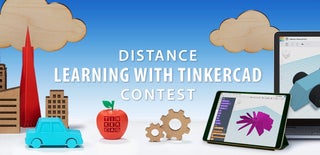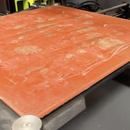Introduction: Room Redesign Project
As we entered distance learning, I, like many educators, needed to find ways to still provide my students with meaningful instruction that was engaging and challenging, yet fair for varying home situations. I teach 6th through 8th grade in Madison New Jersey on the content areas of Technology, Engineering, and Design along with lots of Math, Science, and Art integration. For my "Integrative STEM 6" course with my 6th grade students, I wanted to create an activity that would continue to apply the problem solving and brainstorming skills were covering before distance learning, as well as allow students to use software or other methods in creating some type of visual / 3D model.
The challenge is titled "Room Redesign" and the name sort of says it all. The real-world premise is that we are all stuck at home with a lot more time on our hands and interacting with our families more. Students had to choose a room in their home that could be improved to better accommodate this change in life style, and then redesign it. The project is broken down into four parts, students had approximately one week to complete each part:
- Original Blueprint
- Original 3D Model
- Redesigned Blueprint
- Redesigned 3D model
To accommodate varying interests and lives at home, I left many of the methods for creating these parts open ended, but emphasized the use of Tinkercad as its an application we've been using prior to the activites. Overall, the challenge was very successful, allowing students to demonstrate the utilization of a design process to solve a real-world problem by creating a unique solution. The added flexibility in constraints allowed for greater variety in student work, as well as an increase in engagement. I definitely plan on doing this project again when we return to the classroom next year.
Step 1: Original Blueprint
The first component of the Room Redesign project is to select a room in your home that could be improved. This could be a bedroom, family room, basement, kitchen, whatever! As the objective of the project, this room should have areas that it could be improved in order to better accommodate the greater amount of time we are spending at home with our families.
After choosing a room, students need to create a two-dimensional blueprint of it. As this is a 6th grade class and I wasn't sure about what measuring tools students would have at home, I did not require this blueprint to include dimensions, but instead be proportional in scale...something they were also learning in Math at the time.
Students could choose to create this blueprint neatly by hand drawing it, or digitally in a program like google slides or google drawings. Color was not required, but students did need to label the parts of their blueprints.
See the hand drawn and digitally draw examples of my living room that I created to provide students with examples for inspiration, as well as a few examples of student work attached in the images of this step.
Step 2: Original 3D Model
After creating the original blueprint, it was time for students to make this blueprint of their room into a three-dimensional model to better show the current configuration of their chosen room. As we had been using Tinkercad in previous projects, this is what I recommended my students to use as they were all familiar with it. I created a tutorial of me using Tinkercad to create my living room, not necessarily for students to follow along with but just to reference if they needed a visual example as to how to create a wall or furniture in the program.
To add flexibility, variety, and additional methods for creativity and engagement, I did not require students to use Tinkercad, but allowed for them to choose different methods for creating a 3D model. While most stuck with Tinkercad, some students chose a different app like Minecraft or The Sims while others made a physical model like Legos, Clay, or Paper.
See my Tinkercad tutorial attached in the media for this step, along with some examples of student work from this component of the project.
Step 3: Redesigned Blueprint
Now that we've created a good foundation of where our rooms currently stand, it was time to utilize a design process to redesign and improve our room to better fit the needs of our families. Students had to brainstorm at least five different ways their room could be improved, I did not apply any additional constraints like a budget.
Like the first blueprint, I also did not require measurements but for the blueprint to be proportional to the actual room. Also like the original blueprint, students had to label their drawings whether it be hand drawn or digitally drawn, and label any changes they made.
See the hand drawn and digitally draw examples of my redesigned living room that I created to provide students with examples for inspiration, as well as a few examples of student work attached in the images of this step.
Step 4: Redesigned 3D Model
The final step of the project was to create a redesigned three-dimensional model of their room to better demonstrate the changes they made. Like before, I created a Tinkercad tutorial of me redesigning my living room not for students to follow along to, but to reference how to create a copy of a document, using different tools, and general techniques to support them through this project.
Students again had the flexibility in choosing what type of medium they wanted to use to create this redesigned 3D model. All students stuck with the same method that they used for creating the original 3D model, whether it was Tinkercad, Minecraft, Sims, Clay, Legos, or whatever they could imagine.
See my redesigned Tinkercad tutorial attached in the media for this step, along with some examples of student work from this component of the project.
Step 5: Reflection
This project was really well received by my students, and even engaged many families along the way. The final step of the project was a brief 1 minute presentation where students posted a video describing their redesign model in a flip grid that each student in the class could view. In these presentations, some siblings chimed in, and I received some emails from parents saying that they actually chose some home improvement projects they plan to implement and loved having their children's input.
Teaching Technology, Engineering, and Design in distance learning has been challenging, as I'm sure all other subjects and teachers have experienced. But projects like this have allowed for me to keep the real-world application, even a hands-on component alive while still accommodating for different levels of learners and engagement styles. I absolutely plan to implement this project again next year with some tweaks on constraints and timelines depending on what my classroom setting looks like moving forward.
Thanks for reading, happy making!

Runner Up in the
Distance Learning with Tinkercad Contest











